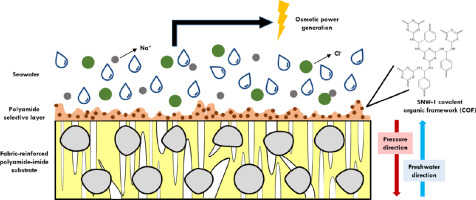当前位置:
X-MOL 学术
›
Desalination
›
论文详情
Our official English website, www.x-mol.net, welcomes your
feedback! (Note: you will need to create a separate account there.)
Melamine-based covalent organic framework-incorporated thin film nanocomposite membrane for enhanced osmotic power generation
Desalination ( IF 8.3 ) Pub Date : 2019-06-01 , DOI: 10.1016/j.desal.2019.02.013 Ralph Rolly Gonzales , Myoung Jun Park , Tae-Hyun Bae , Yanqin Yang , Ahmed Abdel-Wahab , Sherub Phuntsho , Ho Kyong Shon
Desalination ( IF 8.3 ) Pub Date : 2019-06-01 , DOI: 10.1016/j.desal.2019.02.013 Ralph Rolly Gonzales , Myoung Jun Park , Tae-Hyun Bae , Yanqin Yang , Ahmed Abdel-Wahab , Sherub Phuntsho , Ho Kyong Shon

|
Abstract A melamine-based covalent organic framework (COF) nanomaterial, Schiff base network-1 (SNW-1), was incorporated into the polyamide layer of a novel thin film nanocomposite (TFN) pressure retarded osmosis (PRO) membrane. The deposition of SNW-1 was made on an open mesh fabric-reinforced polyamide-imide (PAI) support substrate through interfacial polymerization (IP). SNW-1 loading influence on the water permeability and osmotic power density during PRO operation was investigated. The porous and highly hydrophilic SNW-1 nanomaterial facilitated the flow of water molecules across the membranes, while maintaining satisfactory salt rejection ability of the polyamide selective layer. The membranes exhibited significantly enhanced surface hydrophilicity, water permeability, and power density. The mode of incorporation of SNW-1 during IP was also investigated and it was observed that the secondary amine groups of SNW-1 react with the carbonyl groups of 1,3,5-benzenetricarbonyl trichloride, the acyl halide precursor in polyamide formation; thus, SNW-1 was incorporated through the amine precursor, 1,3-phenylenediamine. Testing with 1.0 M NaCl as the draw solution, the TFN membrane with a loading of 0.02 wt% SNW-1 exhibited the highest water flux of 42.5 Lm−2 h−1 and power density of 12.1 Wm−2, while withstanding hydraulic pressure over 24 bar. This study suggests that COF-incorporation can be a promising method in PRO membrane fabrication to improve both osmotic performance and energy harvesting capability for the PRO process.
中文翻译:

三聚氰胺基共价有机骨架掺入薄膜纳米复合膜增强渗透发电
摘要 将三聚氰胺基共价有机骨架 (COF) 纳米材料 Schiff base network-1 (SNW-1) 结合到新型薄膜纳米复合材料 (TFN) 压力延迟渗透 (PRO) 膜的聚酰胺层中。SNW-1 的沉积是通过界面聚合 (IP) 在开放网眼织物增强聚酰胺酰亚胺 (PAI) 支撑基板上进行的。研究了 SNW-1 负载对 PRO 操作期间水渗透率和渗透功率密度的影响。多孔且高度亲水的 SNW-1 纳米材料促进了水分子穿过膜的流动,同时保持了聚酰胺选择性层的令人满意的脱盐能力。该膜表现出显着增强的表面亲水性、透水性和功率密度。还研究了 IP 过程中 SNW-1 的掺入方式,观察到 SNW-1 的仲胺基团与 1,3,5-苯三羰基三氯化物的羰基反应,这是聚酰胺形成中的酰卤前体;因此,SNW-1 是通过胺前体 1,3-苯二胺加入的。以 1.0 M NaCl 作为汲取溶液进行测试,负载为 0.02 wt% SNW-1 的 TFN 膜表现出最高的水通量为 42.5 Lm-2 h-1 和 12.1 Wm-2 的功率密度,同时承受超过24 巴。这项研究表明,COF 掺入可能是 PRO 膜制造中一种很有前途的方法,可以提高 PRO 工艺的渗透性能和能量收集能力。5-苯三羰基三氯化物,聚酰胺形成中的酰卤前体;因此,SNW-1 是通过胺前体 1,3-苯二胺加入的。以 1.0 M NaCl 作为汲取溶液进行测试,负载为 0.02 wt% SNW-1 的 TFN 膜表现出最高的水通量为 42.5 Lm-2 h-1 和 12.1 Wm-2 的功率密度,同时承受超过24 巴。这项研究表明,COF 掺入可能是 PRO 膜制造中一种很有前途的方法,可以提高 PRO 工艺的渗透性能和能量收集能力。5-苯三羰基三氯化物,聚酰胺形成中的酰卤前体;因此,SNW-1 是通过胺前体 1,3-苯二胺加入的。以 1.0 M NaCl 作为汲取溶液进行测试,负载为 0.02 wt% SNW-1 的 TFN 膜表现出最高的水通量为 42.5 Lm-2 h-1 和 12.1 Wm-2 的功率密度,同时承受超过24 巴。这项研究表明,COF 掺入可能是 PRO 膜制造中一种很有前途的方法,可以提高 PRO 工艺的渗透性能和能量收集能力。02 wt% SNW-1 表现出最高的水通量 42.5 Lm-2 h-1 和 12.1 Wm-2 的功率密度,同时承受超过 24 bar 的液压。这项研究表明,COF 掺入可能是 PRO 膜制造中一种很有前途的方法,可以提高 PRO 工艺的渗透性能和能量收集能力。02 wt% SNW-1 表现出最高的水通量 42.5 Lm-2 h-1 和 12.1 Wm-2 的功率密度,同时承受超过 24 bar 的液压。这项研究表明,COF 掺入可能是 PRO 膜制造中一种很有前途的方法,可以提高 PRO 工艺的渗透性能和能量收集能力。
更新日期:2019-06-01
中文翻译:

三聚氰胺基共价有机骨架掺入薄膜纳米复合膜增强渗透发电
摘要 将三聚氰胺基共价有机骨架 (COF) 纳米材料 Schiff base network-1 (SNW-1) 结合到新型薄膜纳米复合材料 (TFN) 压力延迟渗透 (PRO) 膜的聚酰胺层中。SNW-1 的沉积是通过界面聚合 (IP) 在开放网眼织物增强聚酰胺酰亚胺 (PAI) 支撑基板上进行的。研究了 SNW-1 负载对 PRO 操作期间水渗透率和渗透功率密度的影响。多孔且高度亲水的 SNW-1 纳米材料促进了水分子穿过膜的流动,同时保持了聚酰胺选择性层的令人满意的脱盐能力。该膜表现出显着增强的表面亲水性、透水性和功率密度。还研究了 IP 过程中 SNW-1 的掺入方式,观察到 SNW-1 的仲胺基团与 1,3,5-苯三羰基三氯化物的羰基反应,这是聚酰胺形成中的酰卤前体;因此,SNW-1 是通过胺前体 1,3-苯二胺加入的。以 1.0 M NaCl 作为汲取溶液进行测试,负载为 0.02 wt% SNW-1 的 TFN 膜表现出最高的水通量为 42.5 Lm-2 h-1 和 12.1 Wm-2 的功率密度,同时承受超过24 巴。这项研究表明,COF 掺入可能是 PRO 膜制造中一种很有前途的方法,可以提高 PRO 工艺的渗透性能和能量收集能力。5-苯三羰基三氯化物,聚酰胺形成中的酰卤前体;因此,SNW-1 是通过胺前体 1,3-苯二胺加入的。以 1.0 M NaCl 作为汲取溶液进行测试,负载为 0.02 wt% SNW-1 的 TFN 膜表现出最高的水通量为 42.5 Lm-2 h-1 和 12.1 Wm-2 的功率密度,同时承受超过24 巴。这项研究表明,COF 掺入可能是 PRO 膜制造中一种很有前途的方法,可以提高 PRO 工艺的渗透性能和能量收集能力。5-苯三羰基三氯化物,聚酰胺形成中的酰卤前体;因此,SNW-1 是通过胺前体 1,3-苯二胺加入的。以 1.0 M NaCl 作为汲取溶液进行测试,负载为 0.02 wt% SNW-1 的 TFN 膜表现出最高的水通量为 42.5 Lm-2 h-1 和 12.1 Wm-2 的功率密度,同时承受超过24 巴。这项研究表明,COF 掺入可能是 PRO 膜制造中一种很有前途的方法,可以提高 PRO 工艺的渗透性能和能量收集能力。02 wt% SNW-1 表现出最高的水通量 42.5 Lm-2 h-1 和 12.1 Wm-2 的功率密度,同时承受超过 24 bar 的液压。这项研究表明,COF 掺入可能是 PRO 膜制造中一种很有前途的方法,可以提高 PRO 工艺的渗透性能和能量收集能力。02 wt% SNW-1 表现出最高的水通量 42.5 Lm-2 h-1 和 12.1 Wm-2 的功率密度,同时承受超过 24 bar 的液压。这项研究表明,COF 掺入可能是 PRO 膜制造中一种很有前途的方法,可以提高 PRO 工艺的渗透性能和能量收集能力。















































 京公网安备 11010802027423号
京公网安备 11010802027423号